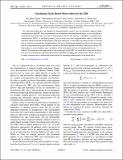Calculating Track-Based Observables for the LHC
Author(s)
Chang, Hsi-Ming; Procura, Massimiliano; Thaler, Jesse; Waalewijn, Wouter J.
DownloadChang_Calculating-track-based.pdf (339.0Kb)
PUBLISHER_POLICY
Publisher Policy
Article is made available in accordance with the publisher's policy and may be subject to US copyright law. Please refer to the publisher's site for terms of use.
Terms of use
Metadata
Show full item recordAbstract
By using observables that only depend on charged particles (tracks), one can efficiently suppress pileup contamination at the LHC. Such measurements are not infrared safe in perturbation theory, so any calculation of track-based observables must account for hadronization effects. We develop a formalism to perform these calculations in QCD, by matching partonic cross sections onto new nonperturbative objects called track functions which absorb infrared divergences. The track function T[subscript i](x) describes the energy fraction x of a hard parton i which is converted into charged hadrons. We give a field-theoretic definition of the track function and derive its renormalization group evolution, which is in excellent agreement with the pythia parton shower. We then perform a next-to-leading order calculation of the total energy fraction of charged particles in e[superscript +]e[superscript -]→ hadrons. To demonstrate the implications of our framework for the LHC, we match the pythia parton shower onto a set of track functions to describe the track mass distribution in Higgs plus one jet events. We also show how to reduce smearing due to hadronization fluctuations by measuring dimensionless track-based ratios.
Date issued
2013-09Department
Massachusetts Institute of Technology. Center for Theoretical Physics; Massachusetts Institute of Technology. Department of PhysicsJournal
Physical Review Letters
Publisher
American Physical Society
Citation
Chang, Hsi-Ming, Massimiliano Procura, Jesse Thaler, and Wouter J. Waalewijn. “Calculating Track-Based Observables for the LHC.” Physical Review Letters 111, no. 10 (September 2013). © 2013 American Physical Society
Version: Final published version
ISSN
0031-9007
1079-7114